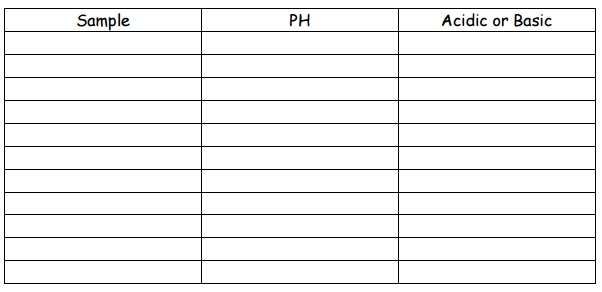Subject: Chemistry
Topic: pH and Water
Time Frame: 50 minutes
Objectives:
- Students will determine the pH of different solutions using indicator paper and a colour chart
- Students will be able to relate pH value to whether a solution is acidic or basic
- Students will examine how our drinking water and lake water is affected by it’s pH
Methodology:
- Group Work
- Laboratory Activities
Materials:
- Lemon Juice
- Vinegar
- Baking Soda
- Cola
- Ammonia
- Bleach
- Contact lenses solution
- Apple Juice
- Baking Soda
- Distilled water
- 1 M HCL
- 1 M NaOH
- Any other solutions the students would like to test
- pH Paper and Colour Chart
- Beakers (to put the liquids in)
- Blank paper, ruler and pencil crayons
Space Requirements:
- This lesson requires enough space for the students to test their samples in a laboratory environment.
Background Information:
- Students should have some background knowledge about acids, bases and pH. Also, students should be familiar with laboratory safety.
Directions/Procedure:
- Have students work in groups of 2 or 3 to determine the pH values for the following solutions.
a. Pour approx. 10mL of each of the samples into different beakers.
b. Place the pH paper in the liquid, and compare the colour to the pH colour chart.
- Have the students determine whether the samples are acidic or basic.
- Using the data obtained, have the students construct and draw their own pH scale using the samples.
- Have the students discuss how water and the surrounding areas would be affected if the pH were changed.
Examples:
-If the pH of water is changed, the taste of the water may change.
-If the pH of the water is too low, it may lead to damage of water pipes due to corrosion. This could cause additional problems if metal has leeched into the water system.
-If the pH of a lake decreases, fish and plant life around the lake may start to die.
- Closure – Ask the students to estimate the pH values of other household items they find at their house.
Evaluation:
Formal Assessment – Marking of their pH scales
Informal Assessment – Observation as the students work together in their groups
Resources:
Environment Canada. Acid Rain FAQ.
http://www.ec.gc.ca/air/default.asp?lang=En&n=7E5E9F00-1#ws2219541E
Safe Drinking Water Foundation. Elementary Operation Water Drop pH Analysis.
www.safewater.org/operation-water-drop-listings/2017/1/14/ph-analysis-for-elementary-operation-water-drop
Safe Drinking Water Foundation. High School Operation Water Drop pH Analysis.
www.safewater.org/operation-water-drop-listings/2016/11/10/ph-analysis-for-high-school-operation-water-drop
pH and Water Assignment - Chart
pH Scale
Draw your own pH scale by using the pH values obtained from the samples. Ensure that you label the pH values, the samples and the acidic and basic sections of the pH scale.


